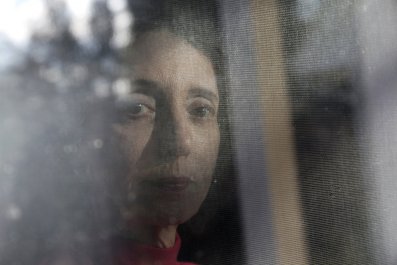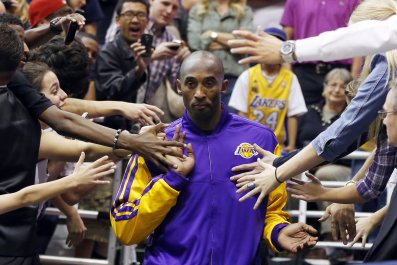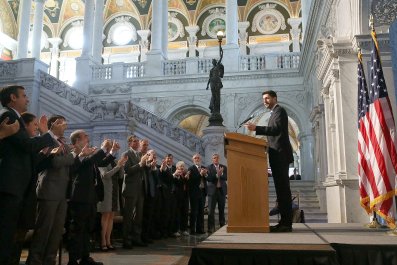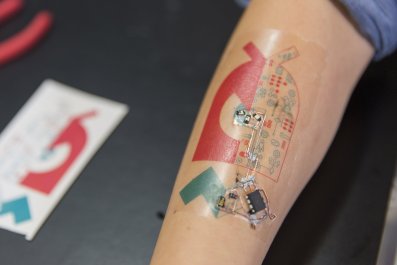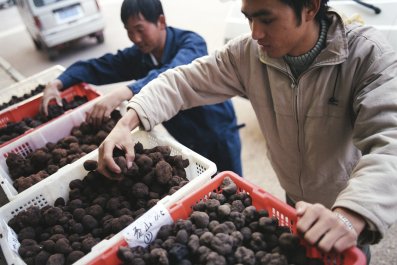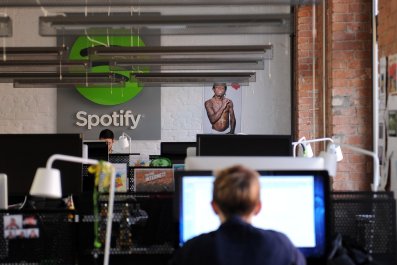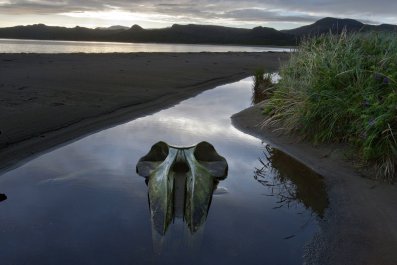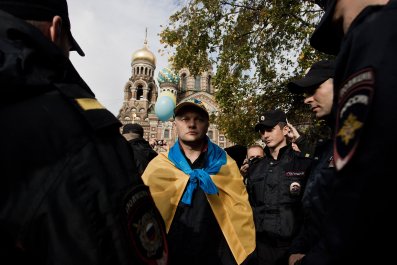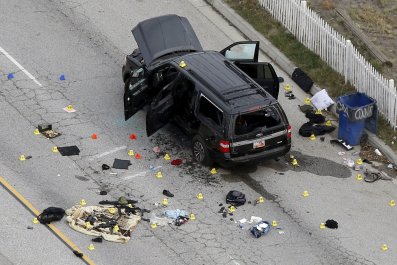The woman married to the heir to the British throne enters the Rape and Sexual Abuse Support Centre in a south London suburb via the fire escape. Camilla, Duchess of Cornwall—she was Camilla Parker Bowles until she married Prince Charles in 2005—doesn't want to draw attention to the location of the center by going through the front door. This choice of entrance keeps photographers who might be waiting for her largely out of sight to passersby and helps preserve the safe unremarkableness of the building, which is vital because the women inside do not want their abusers to find them.
The duchess begins her visit. Each time a member of staff or a victim of sexual violence is introduced to her—there are about 30 women, both victims and helpers–she leans forward, making the interaction a little more intimate than most handshakes between commoners and royalty. The duchess, who is wearing a sober blue-gray suit with two delicate dragonfly brooches on one lapel, does not appear to be unsettled by the rings in the noses of some of the women she is meeting or by the tattoos some of them display on their arms. Nor does she does seem to mind that most of the women don't curtsy or address her as "ma'am," as royal protocol demands.

Located in Croydon, the center provides victims with long-term counseling to help "turn them from a victim to a survivor." The duchess first visited the center in 2009 following a request from Chief Executive Yvonne Traynor. "A lot of celebrities and royals won't touch sexual abuse with a barge pole because it is so hard-hitting," says Traynor. "But she is not like that. She immediately put everyone at their ease, didn't flinch and was not patronizing or pitying." Since 2009, the duchess has visited many other rape centers around the U.K. and on her trips abroad. "She is one of us, an ordinary person who has been thrust into the limelight," says Traynor. "She even carries her own money."
The affection British people like Traynor increasingly feel for Camilla—particularly because of her ability to come across as being of the people rather than of the ruling elite—reflects a dramatic turnaround in the way the British public feels about the woman who was reportedly involved with Charles when he was married to Princess Diana. In a BBC television interview broadcast in November 1995, the princess of Wales publicly aired her feelings about Camilla, without naming her. "There were three of us in this marriage, so it was a bit crowded," the princess said. Try recovering from that sort of public put-down, not least when it is delivered by a beautiful, vulnerable-seeming princess whose huge popularity only grew with her death in a car accident in 1997.
Related: Why Do Americans Fawn Over British Royalty?
But 10 years into Camilla's marriage to Charles, the British public's attitude to her has softened. Whether it has softened enough for her husband to dare make the woman he loves his queen is unclear. People close to the royal family say it has long been his greatest wish that should he become king, Camilla should be crowned alongside him, a move that would seal her journey from maligned mistress to fully accepted partner in life. Charles "hopes the public will eventually come round," says a close royal contact. There may not be a huge amount of time for that to happen. Charles's mother, Queen Elizabeth, will be 90 next year. She appears in good health, but she is almost certainly in her twilight. Observers are increasingly talking about what role Camilla will take in the event Charles becomes king.

Charles knows that he may not get his wish. A royal insider confides to Newsweek that Charles is beginning to accept that the British public has not yet fully accepted her. A poll by YouGov released ahead of Charles and Camilla's 10th wedding anniversary in April 2015 revealed that 35 percent of those contacted said they did not want Camilla to be queen. While 49 percent said they were in favor, there is no constitutional document that states what the wife of a king must be called. The matter is decided by royal prerogative rather than Parliament; in other words, King Charles would have the sole authority over whether his wife would be known as Queen Camilla. Legally, Camilla would automatically become queen if Prince Charles becomes king, but it's not that simple. A statement from Clarence House, the official London residence of Prince Charles and Camilla, issued on the day they married announced that Camilla would be known as princess consort in the event of Charles's accession to the throne.
That would be fine by Camilla. "The duchess is laid back about it," says the close contact. "I don't think she will mind if she is not crowned queen." Camilla's nephew, businessman Ben Elliot, says, "She has no ambition to be queen. She just wants to support her husband." Art historian Roy Strong, who has known Camilla for many years, agrees. "She is not a woman who ever wanted to be queen and by default end up as the king's wife," says Strong. "You don't feel she is a scheming fixer. I don't think that sort of ambition is in her mind."
Whether Camilla becomes queen will depend in large part on how Britons feel about her relationship with two young men who were 15 and 12 years old when their mother died. If there was a nationwide feeling stronger than grief in the remarkable days after Diana's death, it was a shared sense of protectiveness toward the two boys who somehow managed not to cry as they followed their mother's coffin into Westminster Abbey for her funeral on September 6, 1997. Millions of people around the world were crying. Camilla, wisely and inevitably, stayed out of the public eye as much as she could at the time.

But within months, Diana's older son made a perhaps unexpectedly adult decision for a teenager trying to cope with such grief. One day in June 1998, less than a year after his mother's death, William turned up unexpectedly at St. James's Palace, where he had an apartment. St. James's, close to Buckingham Palace, is home to both senior and single royals. Princes William and Harry and the Duchess of Cambridge (formerly Kate Middleton), among others, also have their offices there. Camilla was that day visiting Charles in his apartment.
Prince Charles seized the opportunity and asked William if he would see Camilla. The two had never met. The young prince agreed. Charles brought Camilla to William's apartment, made the introductions and then left. Camilla and William talked for half an hour. It was a potentially explosive encounter and at the very least an extremely stressful one for both parties. When Camilla came out, according to a report in The Sun newspaper, she said: "I need a drink." William wanted to keep the meeting private, but to his fury it was leaked to the press. In a BBC documentary this past February, Sandy Henney, former press aide to Prince Charles, confirmed how angry Prince William had been when details of the meeting were spilled to the press.
Related: Diana: Princess of the World
One encounter couldn't heal the young prince's wounds, and William agreed to see Camilla again–for tea a couple of times and also for lunch. But it took until February 2001 before he consented to be seen officially with her in public. The carefully choreographed occasion was at a London party to celebrate the 10th anniversary of Britain's Press Complaints Commission. William and his father arrived 10 minutes before Camilla, who came with her son, Tom Parker Bowles, and her sister, Annabel Elliot. Charles and William stayed on one side of the room while Camilla stayed on another. Gossip columnists noted this as a significant step forward in the couple's relationship. An insider tells Newsweek, "Prince Charles knew he couldn't marry Camilla until his sons felt more comfortable with her and that the public had become aware of that and sometimes despaired of what seemed an interminable wait."
Harry also found bonding with her difficult. Both boys knew only too well that her existence had tortured their much-loved mother. And Camilla knew that memory would probably always act as an emotional barrier between her and Charles's sons. "To Camilla's credit, she never tried to replace their mother," says an insider.
Charles's popularity plummeted after Diana's death, but by 2002 he was back in public favor, largely because many British people thought he was being a good father. He delayed his longed-for marriage ceremony for another three years, until William and Harry finally came round to the idea. The young princes released a joint statement prior to the wedding: "We are both very happy for our father and Camilla, and we wish them all the luck in the future."
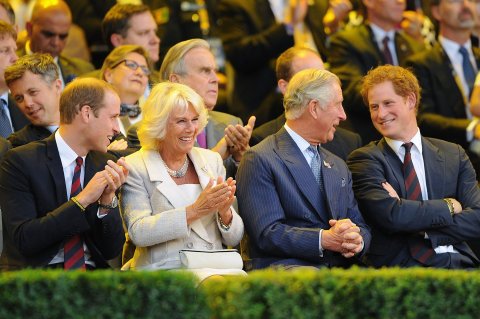
Today, the relationship between stepmother and stepsons appears warm but guarded. A person close to the royals says: "She gets on better now with William and Harry, and they are pleased she makes their father happy, but they are not especially close. She doesn't see a lot of William and Kate, particularly since they moved to their country home, Anmer Hall, in Norfolk. At one time, it was thought the duchess and Kate would bond, but it hasn't happened. William also always makes it clear that Camilla is the wife of his father, but not a stepgrandmother to his children, and that Prince George and his sister Princess Charlotte have two grandfathers, but only one grandmother."
Happily for Camilla, George's and Charlotte's great-grandmother seems to have fully accepted her daughter-in-law. On a recent afternoon, I joined the duchess at an event held at Buckingham Palace Royal Mews by the Brooke, a charity that helps care for working horses, donkeys and mules. Monty Roberts, 80, a well-known American horse whisperer and ambassador for the charity, demonstrated his innovative techniques with a 5-year-old horse that had had minimal contact with people, never worn a saddle or been ridden, to show how she could be trained in 20 minutes to accept a rider, rather than the usual six weeks. The duchess, who is patron of the charity, shares Roberts's passion to bring nonviolent training to the equine world.
A surprise visitor turned up–the queen, taking a break from the state visit of Chinese President Xi Jinping. Camilla kissed her mother-in-law on both cheeks and then curtsied. Both women sat transfixed as Roberts made clucking and kissing sounds; he waved his hands and a long stick with a plastic bag on the end. The horse responded by turning one way, then another and coming to Roberts to be stroked, and then Roberts put a saddle and stirrups on it. Finally, one member of his team mounted and rode the horse round the ring. Throughout, the queen and the woman who, in the words of Strong, the art historian, has made the queen's oldest child "less on edge and more confident in himself" chatted happily and asked Roberts numerous questions.
But it is with her own family that Camilla is most like the sort of person who carries her own money. Camilla and her ex-husband, former Brigadier Andrew Parker Bowles, share two married children: Laura Lopes, who has a daughter, Eliza, 7, and twins Gus and Louis, 6; and Tom, who has a daughter, Lola, 8, and son, Freddy, 5. Tom is a food writer and television presenter. Laura is an art curator.
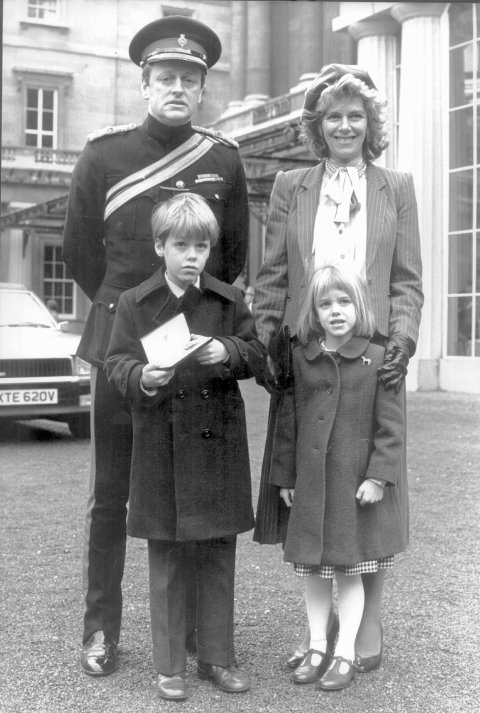
Although the duchess often shares weekends with Charles at Highgrove House, his country home in Gloucestershire, she also maintains the Parker Bowles family's 18th-century manor, Middlewich House, in neighboring Wiltshire. There her grandchildren can run around freely and watch TV shows Charles might not approve of. He is notoriously fussy and doesn't like his things being knocked over, although he regularly travels to join her for dinner on Saturday evenings.
But while the Parker Bowles family members may seem middle class compared with the family Camilla has married into, they're decidedly not. Tom, like his father, is part of the line of succession to the earldom of Macclesfield. Both of Laura's husband's grandfathers were peers of the British realm. Camilla is the great-granddaughter of Alice Keppel, mistress of Edward VII. Camilla came out a s a debutante in 1965, and an inheritance of 500,000 pounds from a member of her mother's family has meant she has never needed to work. Her first wedding, in 1973, was described in the press as the "society wedding of the year." Her future mother-in-law, the queen, was a guest.
Related: Raising a Baby in the New Royal Age
But once you meet the duchess, you understand what Traynor means about Camilla being "one of us." She has a natural warmth, is down to earth and is clearly tenacious. (She and Charles met in 1971 when she was 23 and Charles a year younger; there can't be many women who would wait more than 40 years to marry the man they love.) Turning up, smiling, accepting flowers, shaking hands and supporting various charities is an intrinsic part of life for the wife of a senior royal. But the duchess won't get involved in a charity unless she has thoroughly researched it and feels she can be useful. Camilla is obviously stretching herself to the full: At an age when most people have retired or are close to retiring, she is patron or president of 75 organizations.
The duchess is particularly keen on charities that cover literacy, domestic violence, animal welfare and sick children. She has written that one of her roles is to "shine a light on the violence hiding in the dark corners of our society." Not all royals are quite so willing to venture into the uglier parts of the world they live in. I ask her if the brutal stories she hears linger after she visits places like the counseling center in Croydon. "I think about them a great deal, and they stay at the back of my mind all the time," she replies. "It is often quite harrowing. I do my best to help. If you mind a lot about certain things, as I do, it is easy for me to do as much as I can."
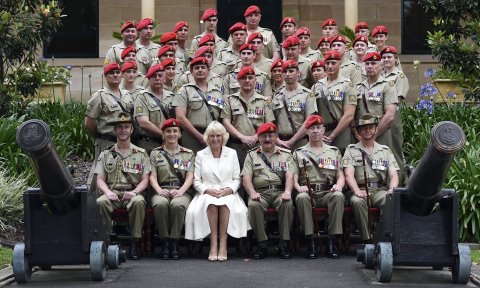
In 1997, the year Diana died, Camilla became patron of a charity—Britain's National Osteoporosis Society—for the first time. A former member of the staff says: "It was the start of carefully chosen public appearances that would hopefully show her in an increasingly good light." The duchess chose this particular charity for her first move into a very traditional royal role because her mother and grandmother had both succumbed to the painful, incurable and inherited illness.
As the years passed after Diana's death, Camilla became an increasingly public figure, even though those Britons reluctant to relinquish the fantasy of the Charles and Diana fairy-tale romance still saw her as the woman who had broken up a happy marriage. Strong says she is much better at her public duties than she was: "At first she was a bundle of nerves, but recently she's grown in assurance."
Like it or not, Camilla must compete with Diana's starry legacy of good works, as well as in her role as the heir to the throne's wife. At a time when many people were afraid to touch people with HIV or AIDS, Diana made sure to be photographed shaking hands—ungloved—with people who had AIDS. She campaigned for an international ban of land mines and was pictured holding on her lap a 13-year-old Angolan girl who had lost her leg to a land mine blast. "I'd like to be the queen of people's hearts," she told the BBC in that famous interview two years before her death, coining a phrase that lingers to this day. Diana was also an inimitable fashion icon. Camilla is known to feel most comfortable in casual clothes and Wellington boots while enjoying country pursuits, but she has recognized that she is constantly scrutinized, and so looking good for her husband has become a priority. Over the last few years, she seems to have grown in confidence and found her own fashion style. Much is due to couture designer Bruce Oldfield.
Speaking to Newsweek about his royal client for the first time, he says: "When she comes for a fitting, I listen to all the niggles about how she perceives her body shape and what she wants to show and not show. They are the sort of niggles shared by most women of her age. For example, few women want to flash their upper arms after 40. The duchess likes creams and soft blues and greens. Last year, I put her into pale pink, a color she was not used to wearing but one she later told me her husband liked, so I scored there. Sometimes, for very formal occasions, she might say her outfit that has bones is not very comfortable. I reply it is not supposed to be comfortable, it is about making her look gorgeous, and ask her to put up with it, which she usually does."
With her growing confidence has come a willingness to use her connections, whether they are political or royal, to help her charities. After leaving Croydon, Camilla and her entourage drove to Nelsons, a British manufacturer of health care products in Wimbledon, also in south London. But the duchess wasn't on her way to Wimbledon for the reason many royals make the trip—to watch a match on the lawn courts of the All England Tennis Club. She had the idea of providing female rape victims with a wash bag of comforting toiletries—which she described as a "crumb of comfort." The women would be given the items following the trauma of post-assault forensic tests at London Havens, specialist centers for people who have been raped or sexually assaulted. Staff at Nelsons had organized a pop-up assembly line. When she was asked if she would she like to help assemble the wash bags, a look of anxiety flashed across her face. "Oh, no," she said at first, looking vulnerable, then agreed, possibly feeling awkward about performaing a manual task in front of photographers. She fumbled at getting the right product in the correct place in the three interlaced transparent wash bags. "I wouldn't get 10 out of 10 for them," she apologized. "I can see it takes a bit of practice."
The duchess knows about practicing. She has been practicing and preparing for years now for the life she will have and for the duties she will take on when Charles becomes king. Will the British public accept her and love her as they did Diana? Probably not in the same way, no. The duchess will never be, and has never tried to be, a second Diana. Queen or princess consort, Camilla's sense of fairness, her stability and her obvious warmth toward those less privileged than herself could yet make the British people cherish her as once they cherished her husband's first wife.
Angela Levin's book Diana's Babies: Kate, William and the Repair of a Broken Family is available on Amazon in paperback and as an e-book.



